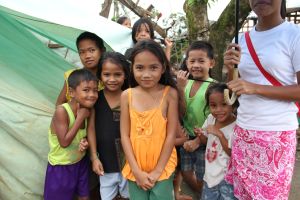
2014 has got off to a dramatic start with a month that has seen me rack up over 25,000 miles criss-crossing the globe. I have spent two weeks on field work for the Independent Commission on Aid Impact – one in the Philippines reviewing the humanitarian response to Typhoon Haiyan which hit last November, and a second in Zambia trying to understand the causes and remedies for child stunting and malnutrition. In both cases I was struck by the tremendous resilience of people and their capacity to bounce back from, and endure, hardships that most of us can only imagine. Speaking of hardships, Sandy and I enjoyed a detox week in a health spa in Cyprus and I travelled to Paris to help Alex find accommodation for the work experience he has just started at Accenture.

As a result of only being in the country for a few days, I have watched from afar the continued drenching of the unremitting rainfall that much of the south of England has endured since before Christmas. There have been parts of the country which have been underwater since then and there has been much anger from affected communities, due to the apparent slowness of response by the authorities to the situation. The electricity and water companies have been vilified for the days of outages which occurred over the holiday period. It is interesting to reflect on how our expectations on everything “working” all the time have been raised, and how quickly the need to blame someone or some organisation becomes the key issue. In the Philippines I saw many communities which have been without electricity since November (and they are not likely to get it back until April at the earliest), while in Zambia I met many small farmers who have to make do with no real access to water for half the year, every year. After the devastation of the typhoon-hit area around Tacloban, I could not help but raise a smile at a headline in the local paper which met me when I got back home to Surrey.
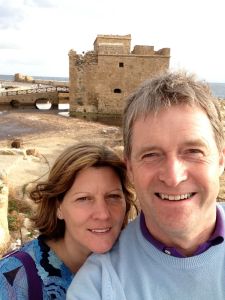
Sandy and I always treat January as a “dry” month and this year we decided to add to the “suffering” by going on a week’s health and wellness break in the winter sunshine of Paphos in Cyprus. We had a daily personal training session, regular massages and organised a diet of healthier meals to accompany our abstemiousness. I must admit that it was a great way to get the year started and even when we were being lashed into shape by Timmis Kambanellis, the local TV personality and personal trainer to the stars, it felt like we were being done some good. The luxury of the hotel was certainly an appropriate counterpoint to the four days I spent the week afterwards in Tacloban!

While in Paris I had a chance to catch up with Pierre Nanterme, the Chairman and CEO, for lunch too and it was interesting to get a sense for the latest strategies and news from the old place, as well as share some of my experiences in the more developing parts of the world. Sandy and I had a great evening with my Accenture colleague John Downie and his wife Marie at the Barbican London staging of the RSC’s Richard II, starring David Tennant in a spell-binding performance in the title role. Meanwhile Matt has been back at school playing a lot of hockey and complaining about his parents always going away on holiday!
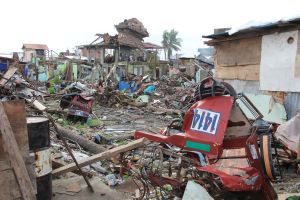
We can all recall the news in November last year, when the terrible pictures of the devastation caused in the Philippines by Typhoon Haiyan were beamed around the world, and reporters were pictured standing amid the tangled mass of rubble and mud in the path of the storm. There was an unprecedented public response to the emerging tragedy which eventually claimed the lives of over 6,000 people and a further 1,700 missing. There was also a huge humanitarian response from countries, UN agencies and NGOs. The UK, through the Department for International Development (DFID), ended up being one of the largest donors to assist the situation, providing some £75m of support. They mobilised their own resources, leveraged the logistical support of the two Royal Navy ships, and contributed to the activities of the multilateral agencies and NGOs on the ground.
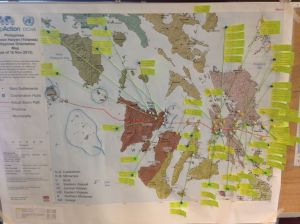
Given the recent nature of the disaster and the scale of the support given, the Commission decided to undertake a special Rapid Review of the effectiveness of this response. So it was that I found myself having a lot of meetings at the start of the year with the recently returned members of the task-force from the CHASE humanitarian department in DFID, as well as the military leadership responsible for their part in the reconnaissance, logistics and aid delivery activities undertaken by the MOD.
The ships, HMS Daring and later the aircraft carrier HMS Illustrious, had been deployed in the days and weeks following the typhoon and been able to travel to the more remote islands which other agencies could not reach. They had been able to deploy vital helicopters to survey the damage and assess needs, bring surgeons from the NHS into the field, as well as lift in cargos when the airports and roads were out. The giant Hercules transport flights undertaken over the disaster zone had brought in vast quantities of supplies, which were then distributed from the airports at Cebu and Tacloban by the various agencies on the ground.
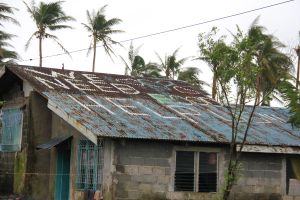
A week later I was in Manila talking to the British Ambassador about the huge coordination effort which was triggered by the onset of the typhoon and the unprecedented nature of its impact. I wanted to understand the level of preparedness that the international community, and the UK specifically, had in advance of the call for help from the Philippine Government. I heard a lot about the stocks of non-food items which are stored in the UK and Dubai in readiness, the air-frieght contracts and other key procurements standing ready to be used, as well as the pre-qualified NGO’s who could be funded in short order and, most importantly, the expert personnel who are able to be deployed to such situations at a few hours notice.
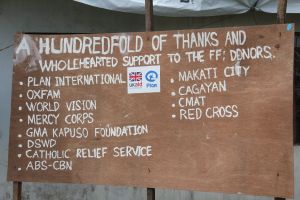
This disaster was one of the first large-scale tests of this preparation and it was also one of the first to trigger the top Level 3 response by the UN system. In Manila and out in the field I spent time with the leadership of the coordinating OCHA group as well as the individual agencies such as UNHCR (immediate shelter), UNICEF (sanitation, children and education), the World Food Programme (emergency food), WHO (medical supplies and clinics), UNDP (debris clearance and cash for work), the Food & Agriculture Organisation (FAO – replacement seeds) and the International Organisation for Migration (IOM – transition shelters) as well as UNFPA (gender protection and victim support). All of these groups were engaged in the immediate aftermath of the storm as were the NGOs such as OXFAM , Save the Children, CARE and PLAN.
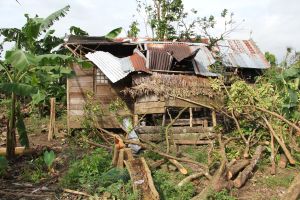
I was able to see the work of all of these organisations on the ground, as well as the efforts of the Philippine Government itself, which led the overall response. It was clear that, although the Philippines is regular hit by typhoons (this was in fact the 25th one to hit in 2013 – call Yolanda in Philippine starting with the 25th letter in the alphabet!), and they had been able to put their storm-readiness procedures into place, the ferocity of the typhoon, its duration over land, and most importantly the storm surge which accompanied it, surprised everyone. As I travelled out to the city of Tacloban and onto the peninsular of Guiuan where the typhoon first hit land, the levels of devastation were mind-blowing.
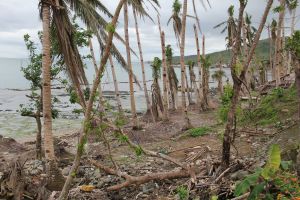
Everywhere beside the roads there were tangled structures of wood, sheet metal and other debris, mixed in with the odd mangled wreck of a car (or even, in one place on the coast, oil tankers lifted out of the water and taken inland). The vast plantations of coconuts which cover much of the island of Leyte, and which provide the majority of the work, looked like they had been mown down by a giant scythe, with trunks either splayed across the hillsides or pointing like stubby fingers into the air, their leaves and fruit shorn off.
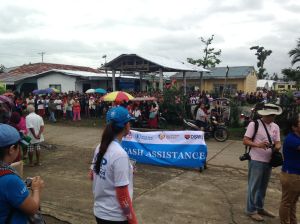
One half of the review team headed out to Cebu and the islands which had been aided by the navy, while I was based in Tacloban for four days in one of the few functioning hotels (which had electricity but no hot water) and travelled out to visit the work of the various groups funded by DFID each day. This was the city which had featured so prominently in the coverage in November and December and it was remarkable to see how much progress had been made in bringing some semblance of normality to the centre. But you did not have to stray too far to find former streets which are still vast expanses of crushed homes, mangled metal and stinking mud. I started at a cash distribution centre organised by the World Food Programme in a village down the coast from the city. They had moved on from providing emergency food to giving the poorest members of the impacted societies the funds to buy vital food, shelter repair and other items.
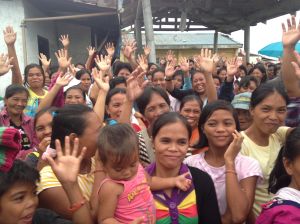
From my very first interactions with the recipients I was struck by their attitude and spirit. The Philippine culture is clearly one of self-sufficiency and proactivity and, while there were still huge deprivations and challenges, they were not only very grateful for all the help that they had received from the international community, but also determined to get on with rebuilding their lives.
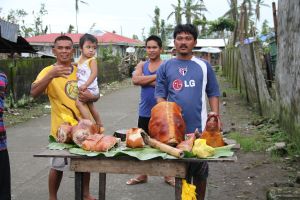
I visited the vast distribution tents which had been the centre of the logistics operation from days after the disaster. The roads have already been largely cleared and it is getting easier and easier to get around the affected areas, but the teams spoke of hacking their way through debris in the early days and weeks, a village at a time, trying to reach the victims. I visited one of these villages with PLAN where I heard from the people about how they had lain on the ground, once their flimsy shelters had collapsed, gripping their children while all hell broke loose around them for hours as the typhoon swirled overhead.
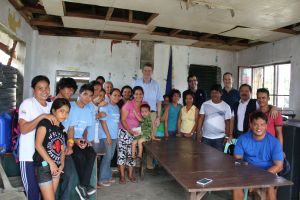
They spoke with gratitude of the various teams who worked their way to them bringing vital water, food and hygiene supplies, as well as the tents for emergency shelter. They had taken advantage of a few days of cash for work, organised by UNDP, to clear some streets and were already turning their minds to growing alternative crops amid the ruined plantations. I was invited into the homes of some beneficiaries of tarpaulins and water filtering bottles provided by OXFAM. They sat amid the flapping sheets in their rebuilt wooden structures planning their next stage of rehabilitation when they had the money.
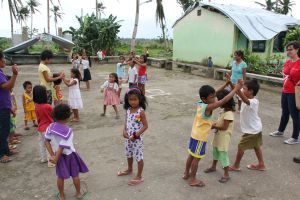
In another village I joined a Save the Children group who had been creating “child-friendly spaces” for young mothers and their children to find shelter and structured play, as well as psychosocial support. It is clear that many of the children have been traumatised by their experiences, to the extent that when the winds get up or it starts to rain they fear the return of the typhoon. I had a long conversation with one of the Philippine psychosocial advisors brought in by Save to a mobile clinic funded by DFID. He encourages his patients to draw pictures of their experiences and he showed me how he interprets the more dramatic drawings of clouds and lightening produced by some children as a cry for help.
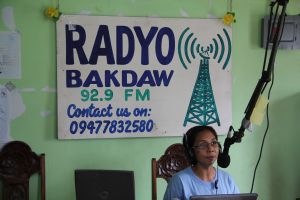
We visited the local community radio station – Radyo Bakdaw – which had been set up with DFID funding in the days after Haiyan, and which still, several months later, remained the only functioning radio station in the region. It had provided vital news to the population about the emergency services and the weather, as well as providing a vehicle for missing members of families to be located. Some of the most affecting sights I saw on my trip were the forlorn pictures of Missing Persons pinned to the notice boards on churches in the impacted areas. The local journalists, who had been trained by the NGO Internews, were energetically engaging with their audience, creating interview segments, and even providing a radio repair service from the tiny shack they operated from. In Guiuan DFID has also been helping to fund the IOM to help with transition shelter and livelihood programmes.
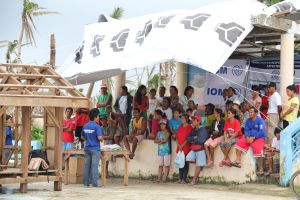
We witnessed a group of families being taught how to build back their shelters in a more resilient manner, to withstand the next storm, and watched a distribution of shelter repair kits including sheets of corrugated steel, nails, glue and tools. Some of the most dramatic images and sounds of this remarkable trip were provided by a coconut lumber cutting programme. Some 40 lumberjacks, equipped with UK-provided chain saws and yellow wellington boots, were to be found hacking down the damaged coconut trunks and sawing them into planks to be used for shelter repair. Only certain, 25 year old, trees are suitable for this and the race is on to use the wood before it rots.
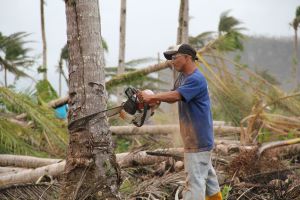
This is providing some immediate work for a few of the local people but the challenge remains that it takes 10 years for a newly-planted coconut palm to produce fruits and the need to find bridging employment at scale is one of the biggest recovery issues. The other is shelter, which for all the efforts outlined above, remains a gigantic task. We passed countless families in villages along the way still living inside the emergency green UKAID-emblazoned tents and it is clear that many of them cannot imagine when they will have the resources to build something more lasting. I met with the regional social services leadership, as well as representatives of the Asian Development Bank in Manila, who are hoping to help with this, but it remains the piece of the UN appeal which is least funded and there is a long way to go.
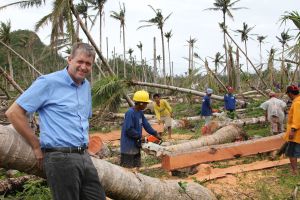
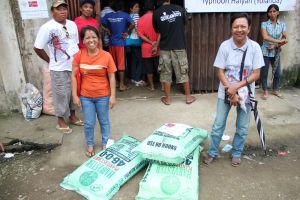
One piece of the medium term story which is good is the apparent success of the emergency rice-planting help, also partially funded by DFID, which I was able to visit. The rice seed stores and early-planted crops had been destroyed by the typhoon, but rapid provision of high quality seeds and distributions of fertiliser meant that the growing season was not missed and these vital foodstuffs are set for a quick return.
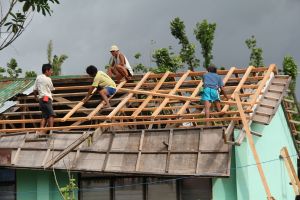
The various UN agencies are already beginning to pull out of the country, and the NGO community is shifting its focus from immediate support to longer term recovery activities, even though the picture of readiness across the impacted districts is very varied. The success of the DEC appeal (which realised over £80m form the UK alone) and other international funding has created a significant potential for extended programming by these international organisations. One of the tricks though, is going to be the ability to calibrate this activity against the relatively high capacity of the Philippine Government and the private sector in what is after all a middle income country.
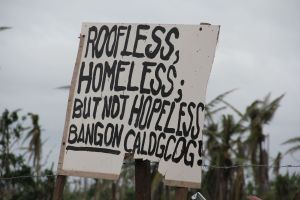
This, taken with the self-starter nature of the wider population, means that a more nuanced and selective approach needs to be taken by the traditional development agencies, some of which have already scaled up to 200-300 personnel on the back of the situation. The UK humanitarian support has been hugely appreciated by the Philippine people we met, and the compassion shown by the British people for a region with which we do not have traditional ties has left its mark. This trip was the first time I have had the privilege of seeing a humanitarian response up close and I was positively impressed by the way that the system worked overall and made a real difference on multiple fronts.
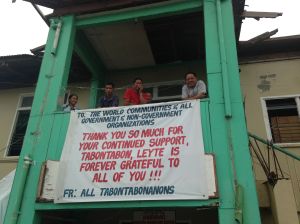
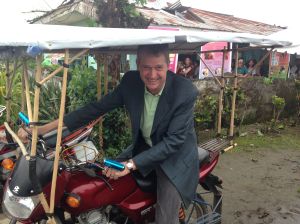
This was just the first of two ICAI trips I made this month. I flew back to the UK and had just six hours turnaround at home before I headed out to Lusaka for the first part of a study into nutrition enhancement programmes, which are designed to tackle the dreadful scourge of stunting in young babies. In the interests of brevity (hurrah I hear you say!), I am going to save that story for what looks to be a quieter February update!


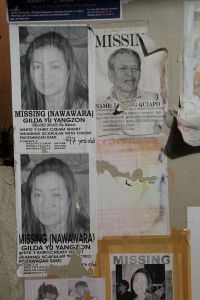
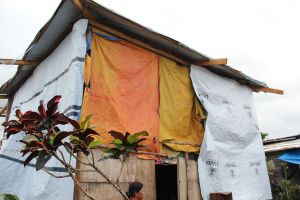
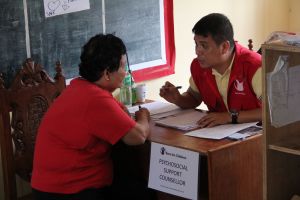
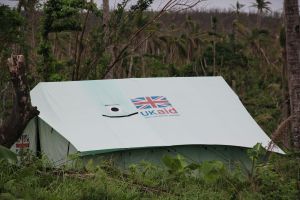
Mark,
The Philippines report was very interesting. It shows a great local and international response, which gets little coverage after the first moments of drama and destruction.
Keith